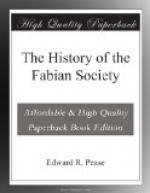* * * * *
We now return to the point whence this digression started. Our local societies were then flourishing. They were vigorously supported from London. We had funds for the expenses of lecturers and many willing to give the time. W.S. De Mattos was employed as lecture secretary, and arranged in the year 1891-2 600 lectures, 300 of them in the provinces. In all 3339 lectures by members during the year were recorded. All this activity imparted for a time considerable vitality to the local societies, and on February 6th and 7th, 1892, the first (and for twenty years the last) Annual Conference was held in London, at Essex Hall. Only fourteen provincial societies were represented, but they claimed a membership of about 1100, some four-fifths of the whole.
The Conference was chiefly memorable because it occasioned the preparation of the paper by Bernard Shaw, entitled “The Fabian Society: What it has done and how it has done it,” published later as Tract 41 and renamed, when the passage of years rendered the title obsolete, “The Fabian Society: Its Early History,” parts of which have already been quoted. This entertaining account of the Society, and brilliant defence of its policy as opposed to that of the Social Democratic Federation, was read to a large audience on the Saturday evening, and made so great an impression that comment on it seemed futile and was abandoned. The Conference on Sunday was chiefly occupied with the discussion of a proposal that the electors be advised to vote at the coming General Election in accordance with certain test questions, which was defeated by 23 to 21. A resolution to expel from the Society any member becoming “an official of the Conservative, Liberal, Liberal Unionist, or National League parties” was rejected by a large majority, for the first but by no means for the last time. The Conference was quite a success, but a year later there was not sufficient eagerness in the provinces for a second, and the project was abandoned.
* * * * *
Amidst all this propaganda of the principles of Socialism the activity of the Society in local government was in no way relaxed. The output of tracts at this period was remarkable. In the year 1890-1, 10 new tracts were published, 335,000 copies printed, and 98,349 sold or given away. In 1891-2, 20 tracts, 16 of them leaflets of 4 pages, were published, 308,300 printed, and 378,281 distributed, most of them leaflets. This was the maximum. Next year only 272,660 were distributed, though the sales of penny tracts were larger. At this period the Society had a virtual monopoly in the production of political pamphlets in which facts and figures were marshalled in support of propositions of reform in the direction of Socialism. Immense trouble was taken to ensure accuracy and literary excellence. Many of the tracts were prepared by Committees which held numerous meetings. Each of them was criticised in proof both by the Executive and by all the members of the Society. Every tract before publication had to be approved at a meeting of members, when the author or authors had to consider every criticism and justify, amend, or delete the passage challenged.




